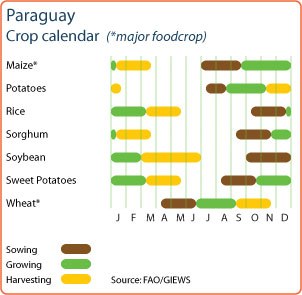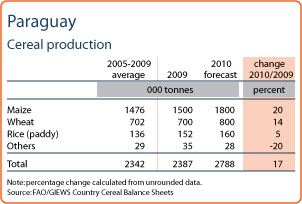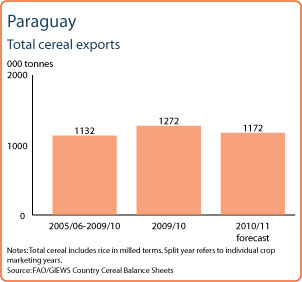Paraguay: Paraguay Agriculture Profile 2012
2012/03/26
Paraguay Agriculture Profile 2012
Reference Date: 13-June-2011
|
FOOD SECURITY SNAPSHOT
|
Increase in area sown to wheat expected in 2011
Sowing of wheat crops of the 2011 autumn-winter season, which will be harvested from September, is in progress in several areas of the country. In the important producing areas of Alto Paraná, in the Oriental region, it is expected that the area sown will increase to 200 000 hectares, compared to the 160 000 hectares sown last year, due to high prices of wheat on the international market. The country exports approximately half of its annual yield of wheat. On the basis of favourable weather conditions and average yields, it is estimated that production will stand at around the same good level reached in the last two years.
Record production of maize in 2011
The 2010 maize harvest has been harvested. Favourable weather conditions during the agricultural season favoured the development and growth of the crops despite the La Niña phenomenon at the end of 2010 and the beginning of 2011. It is estimated that crop yields were above average in all of agricultural areas and there was a sharp increase in maize production. Early estimates indicate an output of approximately 2.2 million tonnes, 21 percent more than in the previous season.
Increase in exports
It is estimated that 2.1 million tonnes of cereals will be exported in 2011, 6.5 percent more than in 2010 and 28 percent above the average for the last five years (2006-2010). Official statistics indicate that in the first four months of 2011 the levels of cereal exported increased by almost 120 percent.
08/12/2010 Dry conditions may affect the forthcoming cropping season
 From June to August, precipitation was generally close to average levels with pockets of dryness persisting in the departments of Concepción, Amambay and Canindeyú. In August, rainfall decreased and water availability deteriorated against seasonal trends causing severe dry conditions in the southern and central departments. Reports from the Ministry of Agriculture indicate that the La Niña event is expected to have strong effects on weather conditions that could reduce further the water availability and recommends adequate water management practices for the forthcoming spring-summer cropping season. In particular, during the coming semester, the La Niña phenomenon might cause a rainfall reduction of more than 40 percent compared to the seasonal average.
From June to August, precipitation was generally close to average levels with pockets of dryness persisting in the departments of Concepción, Amambay and Canindeyú. In August, rainfall decreased and water availability deteriorated against seasonal trends causing severe dry conditions in the southern and central departments. Reports from the Ministry of Agriculture indicate that the La Niña event is expected to have strong effects on weather conditions that could reduce further the water availability and recommends adequate water management practices for the forthcoming spring-summer cropping season. In particular, during the coming semester, the La Niña phenomenon might cause a rainfall reduction of more than 40 percent compared to the seasonal average.
A good wheat harvest is expected in 2010
 Harvesting of the winter wheat crop has just started and the preliminary forecast points to a slight increase in output compared to last year’s drought affected crop. The 2010 wheat harvest is projected at 800 000 tonnes, 14 percent up on last year, due to an increase in area planted, and favourable dry weather conditions. The sharp increase in international prices of wheat is expected to compensate for the costs incurred by farmers and is likely to favourably influence planting intentions in the 2011 cropping season.
Harvesting of the winter wheat crop has just started and the preliminary forecast points to a slight increase in output compared to last year’s drought affected crop. The 2010 wheat harvest is projected at 800 000 tonnes, 14 percent up on last year, due to an increase in area planted, and favourable dry weather conditions. The sharp increase in international prices of wheat is expected to compensate for the costs incurred by farmers and is likely to favourably influence planting intentions in the 2011 cropping season.
Sowing of the important maize crop is nearing completion while planting of sorghum and the key soya crops, to be harvested from January 2011, is underway. Concern is rising among farmers on the scarcity of traditional maize seed varieties mainly due to the increased use of enhanced varieties in Latin American major cereal producers.
The 2010 export estimates point to an increase in the total traded volumes of cereals, mainly due to increased international demand and the good production obtained in 2009.
Scarcity of water is affecting the Chaco region and its people
 According to official sources, the prolonged scarcity of rainfall, particularly affecting the central and northern regions of the Paraguayan Chaco, is reducing the availability of water for human consumption. This is endangering mainly vulnerable indigenous and rural families living in precarious conditions. The region has limited access to fresh water sources and only 6 percent of total population residing in this area have access to potable water.
According to official sources, the prolonged scarcity of rainfall, particularly affecting the central and northern regions of the Paraguayan Chaco, is reducing the availability of water for human consumption. This is endangering mainly vulnerable indigenous and rural families living in precarious conditions. The region has limited access to fresh water sources and only 6 percent of total population residing in this area have access to potable water.
- Related Articles
-
东帝汶农业概况
2012/08/27 更多
-
- Paraguay News
-
- AFGHANISTAN: Global growth will be disappointing in 2016: IMF's Lagarde
- PARAGUAY: Paraguay municipal election on 15 November
- AFGHANISTAN: Revised IMF forecasts signal gloom on global economic outlook
- AFGHANISTAN: Oxfam Study Finds Richest 1% Is Likely to Control Half of Global Wealth by 2016
- PARAGUAY: Paraguayan Senate accepts Venezuela
- PARAGUAY: Paraguay President Horacio Cartes
- Trending Articles
-
- CHINA: United States sees China investment talks ‘productive’ after new offers
- SERBIA: China’s Xi sees Serbia as milestone on new ‘Silk Road’
- AUSTRALIA: Australia taxes foreign home buyers as affordability bites
- INDIA: Indian central bank chief to step down in surprise move
- THAILAND: Foreign investment plummets in junta ruled Thailand
- SOUTH AFRICA: South Africa to extend ICT reach






